Dicho por la prensa
Berliner Morgenpost
Juli 2019
https://www.morgenpost.de/kultur/article226399751/Classic-Open-Air-mit-Highlights-der-Klassik.html
... Für unwiderstehlich weibliche, sensationelle Koloraturen sorgt allerdings Sopranistin Katarzyna Dondalska in der Arie der Olympia. Einem Aufziehautomaten aus Offenbachs „Hoffmanns Erzählungen”. Der Rolle des Roboters aus der Ära der Romantik haucht sie humorvoll Leben ein. Weil Sommer ist, singt sie ungeprobt mal eben Georg Gershwins „Summertime”. Swingt mit Koloraturen. Eine wahre Ausnahme-Künsterin …
(Ulrike Borowczyk)
Me and My World
http://www.musicweb-international.com/classrev/2019/Apr/Dondalska_world_AP0430.htm
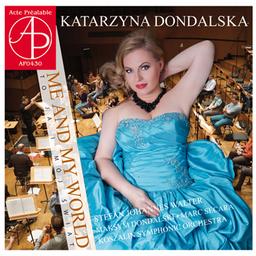
Since April 2010 I have reviewed four discs with Polish soprano Katarzyna Dondalska, here, here, here and here. Here is her latest and it is a real tour de force in coloratura equilibristics. Maybe at the sacrifice of musical substance, but everyone with a liking of nightingales and canaries (one of her earlier discs was titled Nightingale) will have his/her fill of excursions up in the blue. The repertoire is mainly light classics, evergreens, film music and even some video game music. She opens with a couple of Mancini waltzes, including Moon River. The orchestral arrangements are rather overblown but Ms Dondalska’s stratospheric flights are as impressive as ever. In Le Jazz Hotshe indulges in some popular music activities, but her rhythmic security is striking. Krzesimir Dębski’s Helena’s Song is a beautiful melody, first sung as a vocalise, then with text and with her vocalise in the background. The effect is beguiling and the singing impressive.
Gilbert & Sullivan may seem an unexpected choice but it suits her perfectly and she embellish the tune with some weightless coloratura. The Paganini piece, the adagio movement from his fourth violin concerto is a duet for soprano and violin, and it works eminently though I would have liked Maksym Dondalski’s violin to have been more closely balanced. By the way Kata, as she is called in her circle of friends, started her musical career as a violinist at the age of five. More British music follows, Julius Benedict’s traditional showpiece Carnival of Venice, where the final top note is almost unbelievable. Richard Rodgers’s Out of my Dreams from Oklahoma! is beautifully sung and then comes a composer she obviously has taken to her heart, the German Franz Grothe. He wrote a lot of film music, including the score for a German film about the “Swedish Nightingale” Jenny Lind. A song from that film was included in her Nightingale album. Grothe was an excellent tunesmith and in this czardas he invites the soprano to excel in some truly dramatic and temperamental singing. The classic An der schönen blauen Donauis quite overwhelming, and after these fireworks she deserves a short rest, while the orchestra plays a piece by conductor Stefan Johannes Walter, entertaining but rather noisy. His beautiful Vocalise is more to my taste. Peter Kreuder was enormously popular as pianist and composer in the 1930s and his popularity lasted even after the war. Man muss den Männern was bieten is a gently swinging song.
Wojciech Kilar, one of the most prominent Polish composers during the second half of the 20th century, wrote, besides symphonic and choral music, quite a lot of film music and this waltz is from a 1975 movie The Promised Land, directed by Andrzej Wajda. It’s one of the highlights here. Katarzyna Dondalska’s signature operatic role is The Queen of the Night in Mozart’s Die Zauberflöte. Here she performs the aria Der Hölle Rachein a rock-version and adds some extra coloratura. It’s fascinating, though I hope she will sings the original on her next album, which also should include her Rosina from Il barbiere di Siviglia and Zerbinetta from Ariadne auf Naxos. Me and my World, by Stefan Johannes Walter, is another rock number, while Illusion is a nice ballad where Ms Dondalska is partnered by Marc Secara, who has a very agreeable voice. The final number is an example of video game music – a genre I have no experience of. It is big symphonic music where the coloratura soprano is an extra ingredient.
Not all classical singers are comfortable in other genres, but Katarzyna Dondalska not only has wide preferences, she also sounds equally at home in a jazz ballad, a rock number and a classical song. And her technical brilliance and enormous height is stunning. Readers who have already fallen under her spell can safely invest in this latest offering, those who haven’t should give her a try. Maybe the Nightingale album is the best starting point, but you will be just as overwhelmed by her singing here. I’m already waiting for her next issue. An opera recital, Kata?
Göran Forsling
Das Opernglas 4/2019
Acte Prealable ist eine polnische Plattenfirma, die sich zum Ziel gesetzt hat, polnische Komponisten und Interpreten bekannt zu machen. Mit der in Würzburg ausgebildeten Koloratursopranistin Katarzyna Dondalska dürfte das bestens gelingen, denn was sie an Gesangsakrobatik zu bieten hat, das ist phänomenal. Sie will, wie sie selbst sagt, mit diesem Album beweisen, dass klassische Musik sich mit allerlei verschiedenen Genres und Stilen verbinden lässt. Und so führt sie den Hörer von den einschmeichelnden Klängen der Walzer „Moon River” und „The Sweetheart Tree” von Henry Mancini über Kompositionen von Paganini, Johann Strauss und Mozart bis hin zu polnischen Komponisten wie Krzesimir Dębskiski. Freilich erklingt keine der Kompositionen im Original, sondern in effektvollen Bearbeitungen, die allen Freunden des Crossover gefallen werden. Beispielsweise punktet sie in der Rock-Version von „Der Hölle Rache” (aus der „Zauberflöte”) mit glasklaren Koloraturen. In allen Stücken überrascht sie den Hörer mit atemberaubenden, geradezu schwindelerregenden Spitzentönen, auch in langsamen, lyrischen Kompositionen. Es ist eben alles auf sie zugeschnitten, und so verziert sie „Die schöne blaue Donau“ mit ihren Koloraturen, die sie am Ende zu einem wahren Feuerwerk steigert. ,,Me and My World” nennt sie ihr mit dem Orkiestra symfoniczna Filharmonii Koszalińskiej aufgenommenes Album. Der Dirigent Stefan Johannes Walter liefert ihr den genau passenden Sound.
(J. Gahre)
Die Zuversicht siegt
Landeszeitung für die Lüneburger Heide, 24.04.2019
… Den spontanen Beifall in der sehr gut besuchten Kirche heimst Sopranistin Katarzyna Dondalska ein, als sie einen Spitzenton mit einem extrem gewaltigen Crescendo steigert und dabei wunderbar sicher auf dem sehr schmalen Grat zum Schrei bleibt. (…) Die Sopranistin schließlich bringt als Gottesbote Seraph wiederholt dramatische Klangklasse zum Einsatz.
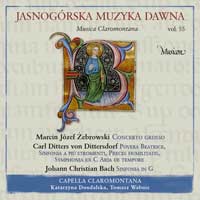 In stratosphärischer Höhe
In stratosphärischer Höhe
Opera Lounge
http://operalounge.de/nicht-benutzen/in-stratosphaerischer-hoehe
(…) Krönung dieser Produktion sind drei Arien von Dittersdorf („Preces humilitatis”, „Povera Beatrice” aus Dittersdorfs Barone di Rocca antica sowie eine „Aria de tempore”). Sie zeigen, dass man in Jasna Góra Sänger allerersten Ranges zu engagieren und/oder auszubilden vermochte, denen die ehrfurchtgebietenden vokalen Schwierigkeiten zuzutrauen waren. Hervorragend gelingt das hier der in Olsztyn und Würzburg ausgebildeten Sopranistin Katarzyna Dondalska. Dem im Begleitheft versuchten Vergleich mit Mado Robin und Bogna Sokorksa muss man nicht folgen. Dondalskas Timbre wird nämlich nicht jedermanns Sache sein, und man hätte sich eine deutlichere Diktion gewünscht, aber ihre sicher geführte, quecksilbrig bewegliche und etwa in der Kadenz der dritten Arie stratosphärische Höhen erreichende Stimme beeindruckt nicht weniger als die lyrischen Töne, die sie für die zweite Arie findet. (…)
Michele C. Ferrari
Józef Wieniawski – Complete Vocal Works (Review 1)
http://www.musicweb-international.com/classrev/2018/Jun/Wieniawski_songs_AP0410.htm
(…) This is a wonderful disc. The performances are excellent. At first, I found Katarzyna Dondalska’s voice a little too operatic for the songs. As I listened again and again this feeling was replaced with one of admiration for how appropriate her voice is. She is wonderful in the duos with Ewa Filipowicz-Kosińska. I have already mentioned my admiration for Damian Chiliński, but the tenor Tomasz Krzysica also deserves top billing. His are the finest songs, and he performs them with aplomb. The Akademia choir are in fine form. As I have said, I wish there were more for them to do. The pianist, Michał Landowski, is excellent throughout. The disc is aided by the good recorded sound and the excellent booklet notes. The only drawback is the lack of translations. This disc has left me wanting to hear more by Józef Wieniwski, so much so that I will be investing in more of his music soon.
Stuart Sillitoe
Józef Wieniawski – Complete Vocal Works (Review 2)
http://www.musicweb-international.com/classrev/2018/May/Wieniawski_songs_AP0410.htm
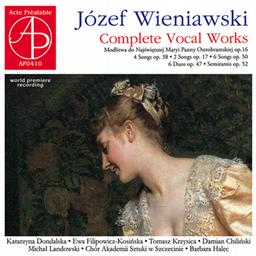
(…)
The first selection, ‘Modlitwa do Najświętszej Maryi Penny Ostrobramskiej’ is a prayer to the Blessed Virgin Mary, Mother of Mercy in the Gate of Dawn in Vilnius, Lithuania, known to the Poles as the Sharp Gate. It contains an image of the Blessed Virgin that dates from the early seventeenth century, believed to have magical healing powers. Wieniawski’s setting is a simple prayer, beautifully sung by soprano Katarzyna Dondalska.
Dondalska features heavily in the recital, displaying an expressive lyric soprano voice and a keen sensitivity to text. Her singing is absolutely lovely, especially in the strophic ‘Piesń wiosenna’ (Spring Song) with its lilting, idyllic accompaniment that ends with a flourish topped off by one of the soprano’s lovely, floated high notes.
She is partnered by mezzo-soprano Ewa Filipowicz-Kosińska in the six duets that make up Op. 47. Filipowicz-Kosińska’s deep, rich low notes contrast perfectly with Dondalska’s sparkling soprano. The duets are the equals of the solo songs in beauty and dramatic breadth. (…)
Concertonet.com
Orange County Renée and Henry Segerstrom Concert Hall 12/29/2017 - & 30 December 2017 (San Diego), 01 January 2018 (Los Angeles)
http://www.concertonet.com/scripts/review.php?ID_review=12826
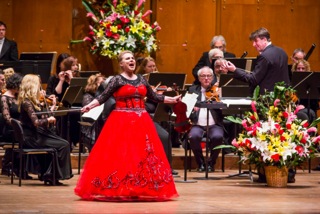
(…) Katarzyna Dondalska is one of the highlights of the evening, particularly when singing her own arias. A bit brassy around the edges, this coloratura has some of the most extraordinary precision in today’s operatic world. After delivering a spunky rendition of “Spiel’ ich die Unschuld vom Lande”, her momentous delivery is found inside Offenbach’s “Les oiseaux dans la charmille.” Excessively spoofy and blatantly humorous, Mlle. Dondalska’s gesticulations are a result of clever crafting, alongside improvisational coloratura which excels beyond expectations: there’s an uncanny manière of pinching the highest of notes without hinting at timidity or exhaustion...her fermatas go on forever and reach into outer orbit! Fabulous delivery …
(Christie Grimstad)
Berliner Morgenpost
Juli 2019
https://www.morgenpost.de/kultur/article226399751/Classic-Open-Air-mit-Highlights-der-Klassik.html
...Für unwiderstehlich weibliche, sensationelle Koloraturen sorgt allerdings Sopranistin Katarzyna Dondalska in der Arie der Olympia. Einem Aufziehautomaten aus Offenbachs "Hoffmanns Erzählungen". Der Rolle des Roboters aus der Ära der Romantik haucht sie humorvoll Leben ein. Weil Sommer ist, singt sie ungeprobt mal eben Georg Gershwins "Summertime". Swingt mit Koloraturen. Eine wahre Ausnahme-Künsterin …
(Ulrike Borowczyk)
Palcem po płycie – Katarzyna Dondalska po raz kolejny
Muzyka21
To już trzecia w pełni recitalowa płyta Katarzyny Dondalskiej nagrana dla wydawnictwa Acte Préalable. W książeczce płyty artystka pisze: „Do nagrania mojej płyty zainspirowała mnie chęć poszukiwania nowych współbrzmień. Chciałam pokazać, że głos jest instrumentem niezwykłym, niepowtarzalnym. We współbrzmieniu z innymi instrumentami potrafi stworzyć cudowną atmosferę, różnorodne nastroje”. I tak usłyszymy 18 utworów kompozytorów uznanych i cenionych, często uwielbianych (Rachmaninowa, Masseneta, Gounoda, Griega, Bernsteina), kilka „perełek koloratury” (Grothe, Nicolai) oraz premierowych nagrań Stefana Johannesa Waltera (prywatnie małżonka śpiewaczki, jej aranżera).
Katarzyna Dondalska należy dziś do najwybitniejszych interpretatorek sopranowych koloratur. Wspaniała technika pozwala jej na wirtuozerię sięgającą rejonów „stratosferycznych dźwięków”. Pewnie dlatego wybitna śpiewaczka operowa Barbara Bonney jej głos nazwała „ósmym cudem świata”. Autor ksiązeczki płyty pisze: „Dondalska jest kontynuatorką sztuki wokalnej legendarnych sopranów koloraturowych Erny Sack, Mado Robin oraz najbardziej fascynującej Bogny Sokorskiej”. Dodałbym jeszcze Adę Sari i Zdzisławę Donat. Działalność artystyczna śpiewaczki obejmuje występy na najważniejszych scenach i estradach świata. Do jej znaczących partii operowych należą Królowa Nocy w Czarodziejskim flecie oraz Konstancja w Uprowadzeniu z seraju” W. A. Mozarta, Zerbinetta w Ariadnie na Naxos R. Straussa, Olimpia w Opowieściach Hoffmanna Offenbacha, Rozyna w Cyrulilu sewilskim Rossiniego i tytułowy Słowik w operze Strawińskiego. Jest finalistką i laureatką wielu konkursów wokalnych dla śpiewaczek koloraturowych(m. in. Gesangswettbwerb Sylvia Geszty w Luksemburgu). W Polsce należała do uczennic Haliny Mickiewiczówny. Sama sprawdza się jako pedagog, w 2011 r. uzyskała stopień doktora wokalistyki. Głos artystki jest zmysłowy, piękny w barwie i w brzmieniu, niesłychanie swobodny w górze skali. Technikę ma opracowaną perfekcyjnie. Wszystkie cechy tego głosu można podziwiać i potwierdzać w nagraniach na omawianej płycie.
Partnerami artystki są instrumentaliści wirtuozi – pianista Timur Enikeev i waltornistka Michelle Perry, artyści w swej sztuce zaiste perfekcyjni. Płytę artystka zadedykowała prof. Piotrowi Kusiewiczowi, wybitnemu śpiewakowi i pedagogowi.
(Jacek Chodorowski)
Die Zuversicht siegt
Landeszeitung für die Lüneburger Heide, 24.04.2019
… Den spontanen Beifall in der sehr gut besuchten Kirche heimst Sopranistin Katarzyna Dondalska ein, als sie einen Spitzenton mit einem extrem gewaltigen Crescendo steigert und dabei wunderbar sicher auf dem sehr schmalen Grat zum Schrei bleibt. (…) Die Sopranistin schließlich bringt als Gottesbote Seraph wiederholt dramatische Klangklasse zum Einsatz.
Koncert Noworoczny - Katarzyna Dondalska w Filharmonii Kaliskie
https://calisia.pl/koncert-noworoczny-katarzyna-dondalska-w-filharmonii-kaliskiej,4594
Wielka śpiewaczka operowa Barbara Bonney, w wywiadzie udzielonym dla Telewizji BBC, po wysłuchaniu śpiewu polskiej artystki, nazwała ją „Ósmym Cudem Świata”.
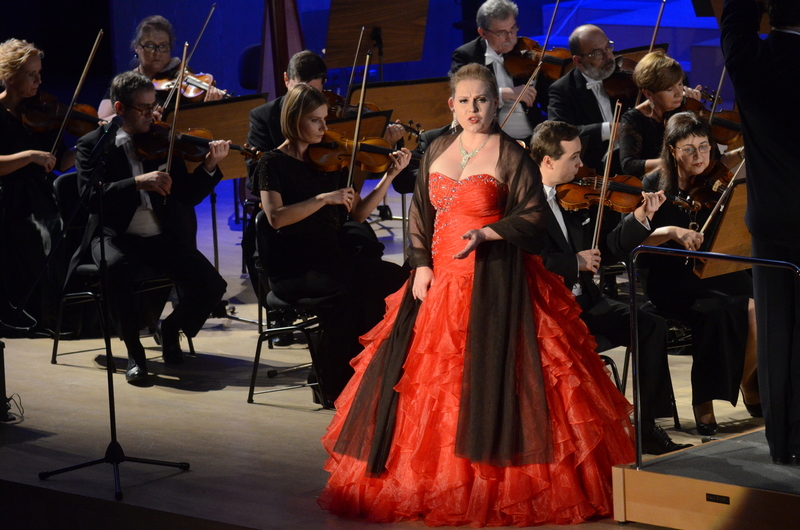 Katarzyna Dondalska wraz z Orkiestrą Symfoniczną Filharmonii Kaliskiej pod przewodnictwem Adama Klocka wykonała wspaniałe walce wiedeńskie, angielskie i francuskie. Sala koncertowa wypełniona była po brzegi. Fenomenalna technika, zmysłowy głos i piękny sopran sprawia, że artystka przyciąga tłumy widzów.
Katarzyna Dondalska wraz z Orkiestrą Symfoniczną Filharmonii Kaliskiej pod przewodnictwem Adama Klocka wykonała wspaniałe walce wiedeńskie, angielskie i francuskie. Sala koncertowa wypełniona była po brzegi. Fenomenalna technika, zmysłowy głos i piękny sopran sprawia, że artystka przyciąga tłumy widzów.
Sopran Katarzyny Dondalskiej zachwyca nie tylko polską publiczność. Występowała na estradach najlepszych sal koncertowych m in. New York Avery Fisher Concert Hall, Disney Concert Hall Los Angeles, Washington John F. Kennedy Center for the Performing Arts, Chicago Music Hall.
Jako pierwsza dokonała nagrań arii Karla Dittersa von Dittersdorf, oraz pieśni religijnych Ottona Mieczysławy Zukowskiego. W roku 2015 została doktorem habilitowanym sztuki muzycznej. Funkcje Profesora Nadzwyczajnego w Akademii Sztuki w Szczecinie uzyskała w październiku 2015 roku.
Najnowsza płyta to "Dream with me " z utworami, Gounoda, Masseneta , Waltera, Rachmaninoffa, Griega i Bernsteina.
(Zobacz Także, fot. FELA)
Recording of the month: Dream with Me
www.musicweb-international.com/classrev/2017/Jan/Dream_Dondalska_AP0370.htm
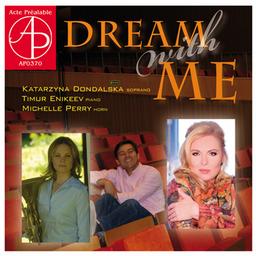 A couple of years ago I reviewed a disc titled “Nightingale” with Katarzyna Dondalska (review). The programme was really charming, presenting songs about birds. Many of them dealt with nightingales – a bird that needs a good coloratura soprano. Katarzyna Dondalska is a very good coloratura soprano and the disc was a success. Now she is back with a new mixed programme, and while she has abandoned the nightingales (well, not quite) she has generous opportunities to make excursions up in the blue. As for her capacity it remains truly impressive. Many sopranos never reach those heights at all, some do but only with difficulty, only a few feel comfortable up there. Dondalska feel very comfortable and seems to have no problem finishing a phrase pianissimo. Her coloratura is immaculate too and the only fault I can register is a certain hardness of tone in some places.
A couple of years ago I reviewed a disc titled “Nightingale” with Katarzyna Dondalska (review). The programme was really charming, presenting songs about birds. Many of them dealt with nightingales – a bird that needs a good coloratura soprano. Katarzyna Dondalska is a very good coloratura soprano and the disc was a success. Now she is back with a new mixed programme, and while she has abandoned the nightingales (well, not quite) she has generous opportunities to make excursions up in the blue. As for her capacity it remains truly impressive. Many sopranos never reach those heights at all, some do but only with difficulty, only a few feel comfortable up there. Dondalska feel very comfortable and seems to have no problem finishing a phrase pianissimo. Her coloratura is immaculate too and the only fault I can register is a certain hardness of tone in some places.
The programme is varied and includes a lot of songs and composers that most of us are unfamiliar with. For how many are Harriet Ware, Charles Gilbert Spross, Gaetano Braga, Gustav Rebling and Franz Lachner household names? We can’t expect all these songs to be masterpieces, but they are melodious and attractive in an unpretentious way, and they are not easy for the performers.
The title of the collection is “Dream with Me” but it should by rights be “Dream with Us”, since the excellent horn player Michelle Perry takes part in every number bar one and actually has one solo of her own. Pianist Enikeev is an important participant and Katarzyna Dondalska also plays the violin in one piece. She studied violin from the age of five and only took up singing when she was fifteen. Whether she sings and plays simultaneously I don’t know, but the playing is excellent.
The idea of combining the bright soprano voice with the mellow tones of the French horn was brilliant. Often the horn plays an introduction – as in the opening Rachmaninov song – and pops in between stanzas and plays a postlude as well. In many songs they sing together – and Michelle Perry’s horn really sings – so even though you have heard some of the songs before, you get a new perspective on them this time. The Rachmaninov is such a case, Massenet’s Élégie another. Both are well-known. Harriet Ware was an American teacher, who did a lot to educate lower class children and adults and founded the Children's Friend Society. The entry on her on Wikipedia doesn’t say a word about possible musical activities. Charles Gilbert Spross was also American. He was a pianist who travelled the world as accompanist to singers, violinists and other instrumentalists. Gaetano Braga, Italian cellist, wrote music for his own instrument and a number of operas that haven’t been played for ages. Josef Mysliveček, the earliest of the composers on this disc, was Czech and an important figure in late 18th century music life. He was a close friend of the Mozart family and is often mentioned in Wolfgang Amadeus’ correspondence. He wrote more than 25 operas, many of them to librettos by Metastasio. Il Bellerofonte was only his second opera, premiered in Naples in 1767. The aria is long and lively with a lot of coloratura. Carrie Jacobs-Bond was an American singer and pianist who wrote about 175 songs, some of them being great hits. I Love You Truly (1901) and A Perfect Day (1910) are still frequently performed. A Perfect Day is a personal favourite of mine and I was delighted to find it on this disc. Even though I prefer Benjamin Luxon’s warmer baritone voice I’m sure I will play Dondalska’s version just as often in future.
Gustav Rebling was a German conductor and composer, one of the most important choir leaders during the second half of the 19th century. Waldessehnsucht (Longing to the Forest) is a fine little song, where the French horn contributes real forest-feeling. Forest-feeling is also present in Solvejgs Sang. It is from the incidental music to Ibsen’s Peer Gynt and one can imagine the girl standing alone in the forest with her birch-bark horn, playing first a sad melody, then she sings and between the stanzas we hear the horn again. At the end she plays again. The German composer and conductor Franz Lachner was a major musical profile during his lifetime but is today largely forgotten. Readers who have Italian language recordings of Cherubini’s Medea should be aware that the recitatives are composed by Lachner. The French original was an opera comique (with spoken dialogue) but when it was played in Frankfurt in 1855 Lachner was commissioned to write recitatives and that version was adopted also in Italy. Lachner also composed a large number of songs, several settings of the same poems that Schubert had set. Frauenliebe und Leben heard on this disc is a fine piece, but we think more of Schumann when we see the title.
Otto Nicolai is remembered for two things: he was the founder of the Wiener Philharmoniker and he wrote the opera Die lustigen Weiber von Windsor, which is still played. The piece on this disc with the full title Variazioni concertanti su motivi favoriti dell'opera La sonnambula di Bellini, per soprano, corno e pianoforte oppure violoncello o clarinetto, Op. 26 is a true virtuoso piece, a tour de force for both singer and horn player. The soprano is allotted Amina’s final aria Ah! non giunge uman pensiero where she rejoices when everything is sorted out.
Rachmaninov’s well-known Vocalise is heard here with a horn part added, composed by Stefan Johannes Walter, Katarzyna Dondalska’s husband, who is also responsible for the horn arrangement of the first Rachmaninov song and contributes two compositions of his own: another Vocalise (tr. 16) with a lovely melody, and Soggetti Italiani (tr. 17), lively rhythms, charming and fun with a hearty march rounding off the piece. Before these two we also hear the nightingale piece I mentioned earlier. On her previous disc she included no fewer than four songs by Franz Grothe, who wrote a tremendous amount of film music, including Die Schwedische Nachtigall about 19th century virtuoso Jenny Lind. Here comes one more song from that 1941 film; it was originally sung by the legendary soprano Erna Berger.
It is interesting to hear Massenet’s Meditation from the opera Thaïs, written in the original for violin solo, played by the French horn. The full and round tone of the instrument adds warmth.
Leonard Bernstein’s Dream with me was written for his musical Peter Pan, which was premiered in 1950. It was intended as a full-blown musical but it was performed with only five songs – songs that were suited to the limited vocal resources of the actors. Dream with me was not one of those five. Not until 2000 was the full score unearthed and was recorded and later also staged. It is sad that this lovely song was never heard during Bernstein’s lifetime. It makes a sensitive, lyric finale to this really lovely recital.
If you love beautiful melodies – known or unknown – performed by wonderful artists you should definitely hear this disc. You will love it.
Göran Forsling
Katarzyna Dondalska: Love (Acte Prétable, Klassikcenter Kassel)
svensopernparadies.wordpress.com/2016/09/14/katarzyna-dondalska-love-acte-pretable-klassikcenter-kassel/
Eine hell timbrierte, brilliante Sopranstimme mit einer markanten, geradezu phänomenalen Höhe und einer musikalischen Intelligenz, die es ihr, wie häufiger auf der CD zu erleben, gestattet, eigenständig Koloraturen zu kreieren, welche immer pointiert ausgeformt werden. Gleich bei der ersten Arie „Je veux vivre“ werden eigene Koloraturketten pointiert und deliziös in ihrer virtuosen Ausformung geboten. Mit einem außergewöhnlichen Fingerspitzengefühl gesegnet, formt sie die Arie „O mio bambino caro“ aus. Auch der nachfolgende Parla Waltz von Arditi wird grandios ausgeformt. Bei den Operettenarien „Liebe du Himmel auf Erden, Meine Lippen…, Mein Herr Marquis (sensationell), Musikanten sind da, Immer wenn ich glücklich bin“, legt sie die gleiche Ernsthaftigkeit an den Tag wie bei den vorangegangenen Opernarien. Ebenfalls grandios in der Ausformung und auch in dem Setzen eigener Koloraturen gestaltet sie die Arie der Olympia aus dem Hoffmann, „Les oiseaux dans le charmille“: einer der Höhepunkte dieser CD. Die von dieser polnischen Sängerin gesetzten Töne sind reinste Stimmakrobatik und entwickeln am Ende dieser Arie eine Tessitura, die selbst unter den hohen Sopranstimmen derzeit unerreicht sein dürfte. Abgeschlossen wird die CD mit einer deliziös anmutenden Interpretation von Loewes’s „I could have dance all night“. Begleitet wird sie von Natan Dondalski (Violine), Monika Dondalski (Violine), Malgorzata Niemiec (Viola) und Wiktor Cison (Cello): klangschön und sehr professionell. Gerade auch diese „bescheidene“ Begleitung macht den besonderen Reiz dieser CD aus: eine der ganz großen Überraschungen des Jahre 2016.
Love: Heaven on Earth – Review
www.musicweb-international.com/classrev/2017/Mar/Love_Dondalska_AP0348.htm
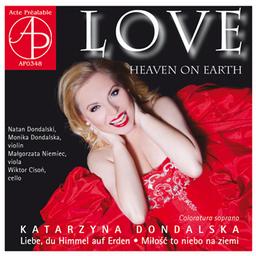 This is the fourth disc with Katarzyna Dondalska that has come my way for review, and I know there are more. The previous one, Dream with me, reviewed in January this year, was recorded as recently as August 2016, so the present one is a good year older. Katarzyna Deondalska builds her programmes thematically. I am sure she does so with her recital programmes too. A couple of years ago the theme was Nightingale, fitting for a coloratura soprano, and here focus is on Love. As in earlier programmes, she manages to find composers and works a bit off the beaten track. This time there are also some real finds that I will add to my list of “new friends”. She has also chosen to be accompanied by a string quartet instead of a piano, and this works eminently well. The selections on this CD give her opportunities to show off her effortless coloratura technique. Here and there she adds embellishments and interpolates stratospheric notes not found in the original. All this is done with elegance and sometimes tongue-in-cheek. I do not mind, even though Olympia’s aria from Les Contes d’Hoffmann is a bit over the top—but I love it even so.
This is the fourth disc with Katarzyna Dondalska that has come my way for review, and I know there are more. The previous one, Dream with me, reviewed in January this year, was recorded as recently as August 2016, so the present one is a good year older. Katarzyna Deondalska builds her programmes thematically. I am sure she does so with her recital programmes too. A couple of years ago the theme was Nightingale, fitting for a coloratura soprano, and here focus is on Love. As in earlier programmes, she manages to find composers and works a bit off the beaten track. This time there are also some real finds that I will add to my list of “new friends”. She has also chosen to be accompanied by a string quartet instead of a piano, and this works eminently well. The selections on this CD give her opportunities to show off her effortless coloratura technique. Here and there she adds embellishments and interpolates stratospheric notes not found in the original. All this is done with elegance and sometimes tongue-in-cheek. I do not mind, even though Olympia’s aria from Les Contes d’Hoffmann is a bit over the top—but I love it even so.
Juliette’s waltz-aria from Roméo et Juliette is an enticing opening number. No listener can in all likelihood be indifferent to Dondalska’s amazing coloratura. O mio babbino caro, on the other hand, is so touching that interpolated top notes would have been tasteless. She just sings it sensitively and nuanced, and her high pianissimo tones are delicious. Luigi Arditi’s two showpieces are classic nightingale repertoire. Her pinpoint coloratura is phenomenal. Toselli’s Serenade was for many years standard repertoire for restaurant trios everywhere, but it is a song, sentimental yet beautiful, and it is lovely sung here. Lehár contributes two operetta hits and Strauss Jr one. Even though we have heard them uncountable times, we are happy to hear them again. The one from Paganini is not that hackneyed, by the way. In between those arias we find a real gem, unknown to me anyway: Vocalise from Polański’s 1999 film The Ninth Gate. It is enormously beautiful and Dondalska sings it so exquisitely. I have become very fond of Kilar’s music, not least his choral music, but this Vocalise goes straight to my list of favourites.
Franz Grothe, represented on two previous discs with Katarzyna Dondalska, reappears here. A skilled melody-maker, he wrote music for about 170 films. The three songs on this disc are charming. In particular, Immer wenn ich glücklich bin has a really catchy tune. Gerhard Winkler was another German composer of popular music during the same period as Grothe. He had a world hit in 1952 with Mütterlein (in English Answer Me). Komm, Casanova is a charming song too, but the real find, together with Kilar’s Vocalise, is another vocalise by Krzesimir Dębski, composer, conductor and jazz violinist. The vocalise comes from a recording, Ogniem i mieczem, from 1999 which sold Platinum in Poland. Dondalska sings it so beautifully, and her voice blends so deliciously with the strings. I could have danced all night from My Fair Lady is a fine finale, but I have never heard it with such a lot of embellishments.
Lovers of coloratura sopranos will have their fill here. I am completely bowled over by Katarzyna Dondalska’s singing, not only for her technical brilliance but also nuanced readings. The string quartet play well and the recording balance is ideal. I would have liked some information, though, on some of the lesser known composers.
Göran Forsling
Salute to Vienna Rings in 2016 in Grand Style
January 1st 2 pm, Roy Thomson Hall
blog.scena.org/2016/01/salute-to-vienna-rings-in-2016-in-grand.html
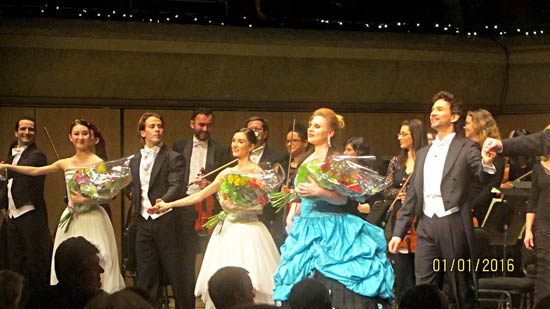 Strauss Symphony of Canada /
Strauss Symphony of Canada /
Imre Kollar, conductor
Katarzyna Dondalska, soprano
Franz Gurtelschmied, tenor
Dancers from the Hungarian National Ballet
International Champion Ballroom Dancers
I attended the January 1st 2016 edition at Roy Thomson Hall. The repertoire focused on Strauss waltzes and polkas, operettas, ballets, comedy, and the like, nothing too challenging for the festive audience out to have fun. Hungarian maestro Imre Kollar doubled as the master of ceremony and stand-up comic, in addition to his regular conducting duties. Kollar is blessed with the "gift of the gab" so to speak - in fact he's a veritable Hungarian Victor Borge, corny jokes and all. Polish soprano Katarzyna Dondalska and Austrian tenor Franz Gurtelschmied were the two singers, joined by six dancers from the Hungarian National Ballet and two couples of International Ballroom Dancing Champions ...
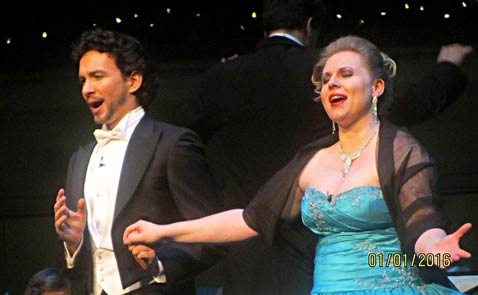 ... The program was made up entirely of warhorses. An early highlight was the dazzling showpiece Fruhlingsstimmen by Johann Strauss. This aria tests the stratospheric reaches of a coloratura soprano, the final high note is a B flat above high C. Historically, quite a few singers made a specialty of this, including Mado Robin, Erna Sack, and Miliza Korjus. More recent examples include the late Lucia Popp, Natalie Dessay, Diana Damrau, Sumi Jo, and Kathleen Battle. Well, Frau Dondalska could belt it out with the best of them. Also amazing is her violin playing, Gypsy style. Her website mentions she took up the instrument at age 5! She was partnered in duets from Die Fledermaus and Land of Smiles by the Austrian Gurtelschmied. His is a more modest if pleasant musical theatre voice, with a forward/open placement and almost Italianate sound. He sang "Dein ist mein ganzes Herz" very well, although he got tired near the end of the concert ….
... The program was made up entirely of warhorses. An early highlight was the dazzling showpiece Fruhlingsstimmen by Johann Strauss. This aria tests the stratospheric reaches of a coloratura soprano, the final high note is a B flat above high C. Historically, quite a few singers made a specialty of this, including Mado Robin, Erna Sack, and Miliza Korjus. More recent examples include the late Lucia Popp, Natalie Dessay, Diana Damrau, Sumi Jo, and Kathleen Battle. Well, Frau Dondalska could belt it out with the best of them. Also amazing is her violin playing, Gypsy style. Her website mentions she took up the instrument at age 5! She was partnered in duets from Die Fledermaus and Land of Smiles by the Austrian Gurtelschmied. His is a more modest if pleasant musical theatre voice, with a forward/open placement and almost Italianate sound. He sang "Dein ist mein ganzes Herz" very well, although he got tired near the end of the concert ….
(Joseph So)
Berlin Classic open air – Jubel zum 25. Geburtstag
Theater Magazin Orpheus (09/2016)
… Katarzyna Dondalska (als Berliner Nachtigall kann man sie mittlerweile trällern hören) präsentierte ihre unglaublichen Koloraturen als Rosina, und in der Glöckchenarie sind sie stratosphärisch überwältigend.
… Katarzyna Dondalska übernahm für eine erkrankte Kollegin in blendender Sommerstimmung den »Frühlingsstimmen«-Walzer und brillierte im Rausch der Höhen.
Krzysztof Kaluzinski
Stehende Ovationen
Südwest Presse (28.7.2015)
... Gerafft und gerüscht legten sich die Philharmoniker in diese barocke Musikpracht und Katarzyna Dondalska, im Barockkleid voller Spitzen und Rüschen, überzeugte mit einer innigen Darbietung dieser Händel-Arie. Das dunkle Timbre der Sopranistin verschmolz mit dem tiefen Schmerz dieses Liedes „Lass mir die Klage“.
Und dann, nach der Pause mit Champagner und Schnittchen, die durch die Interpretation von Maria Callas berühmt gewordene Arie „Una voce pocco fa“ aus der Rossini-Oper „Der Barbier von Sevilla“: Welch großartige Stimmakrobatik bot da die Koloratursopranistin Katarzyna Dondalska. Wie losgelöst von der Schwerkraft purzeln die Koloraturen und springt ihre voluminöse, samtig gefärbte Stimme zwischen den Tönen hin und her. Das löste nicht nur frenetischen Beifall, sondern erste Bravorufe aus. Wie ausgewechselt dann Stimme und Darstellung der Sängerin in der Annenpolka von Johann Strauß, die Einzug gefunden hat in seine Volksoperette „Eine Nacht in Venedig“: Ein Glas Champagner in der Hand stolperte die Sopranistin auf die Bühne, spielte brillant prickelnde Champagnerlaune und sang mit dem hellen Timbre einer Soubrette dieses beliebte „Schwipslied“… Stehende Ovationen waren der wohlverdiente Dank.
SABINE GRASER-KÜHNLE
WALENTYNKI W FILHARMONII; prosimy częściej w Krakowie!
(15.2.2015)
… Katarzyna Dondalska po raz pierwszy występująca na krakowskiej filharmonicznej estradzie zaprezentowała się w Odgłosach wiosny Straussa i arii Adeli ze Straussowskiej Zemsty nietoperza oraz we wspomnianych piosenkach z repertuaru Marylin Monroe. Artystka słynie z koloratury, ma ją rzeczywiście oszałamiającą, ale nie to mnie ujeło w sobotę, lecz jej muzykalność i swoboda z jaką wykonywała bardzo zróżnicowany repertuar oraz sam gatunek gatunek głosu jakim dysponuje. Mówiąc "koloratura" mamy z reguły na myśli jasny lekki sopran. Tymczasem Katarzyna Dondalska z lekkością i łatwością wyśpiewuje wszelkie fioritury głosem okrągłym, nasyconym pełnią barw charakterystycznych raczej dla sopranów spinto. A wykonana na bis Dumka z Ogniem i mieczem porwała wszystkich. Urzekający głos, wspaniała śpiewaczka! Prosimy częściej w Krakowie!
Anna Woźniakowska
Berliner Morgenpost (05.07.14)
Bei "Tosca" hallte Fußball-Jubel über den Gendarmenmarkt
"Classic Ladies" war das Motto des Abends beim Classic Open Air auf dem Gendarmenmarkt. Es war ein Konzert stilistischer Vielfalt und musikalischer Frauenpower. Und auch ein Ball flog ins Publikum.
Von Peter E. Müller
...Der Koloratursopran der aus Polen stammenden Katarzyna Dondalska perlt wie gekühlter Prosecco. Die blonde Sängerin überrascht mit Franz Lehars "Liebe, Du Himmel auf Erden" und spielt sogar selbst die Geige dazu. Später betört sie mit der Arie der Olympia aus Jacques Offenbachs "Hoffmanns Erzählungen"…
Mainpost (27.06.2014)
"Kissinger Sommer"
Was heißt denn Liebe?
Toujours l'amour: Katarzyna Dondalska, Hélène Hébrard, Dmitry Korchak und Maciej Pikulski boten ein buntes Programm.
von THOMAS AHNERT
Bad Kissingen — "Toujours l'amour" - "Immer die Liebe". Ein unerschöpfliches Thema in allen Sprachen für jemanden, der ein Programm für einen Lieder- und Arienabend zusammenstellt.
Und so bunt wie das Register der 31 Lieder und Arien war auch die Truppe, die im Rossini-Saal zusammengekommen war: die polnische Sopranistin Katarzyna Dondalska, die in Berlin lebt, die französische Mezzosopranistin Hélène Hébrard, die in ihrem Heimatland wohnt, der russische Tenor Dmitry Korchak, der sich in Wien niedergelassen hat, und der polnische Pianist Maciej Pikulski, der seine Zelte in Paris aufgeschlagen hat.
Und so unterschiedlich wie die Herkunft waren auch die Stimmen und Charaktere. Katarzyna Dondalska ist eine fabelhafte Koloratursopranistin mit einer Neigung zur Verschwierigung ohnehin schon waghalsiger Melodielinien. Und es war auch schön, dass eine Muttersprachlerin Lieder von Chopin und Arien von Moniuszko sang, weil die phonetische Vertracktheit klar wurde. Aber sie ist auch im französischen und italienischen Fach bestens verankert, wobei sie eine Höhe besitzt, die die Königin der Nacht zur Altistin macht. Immer wenn man glaubte, dass sie bei den Arienschlüssen die absolute Höhe erreicht hatte, setzte sie noch einen Sprung nach oben drauf. Natürlich musste sie um diese Töne ringen, aber sie obsiegte und es gelang ihr auch noch, sie zu halten. Rätselhaft, wie sie das macht. Und die Arie der Olympia aus "Hoffmanns Erzählungen" wurde zu einem köstlichen Zeugnis ihrer selbstironischen Schauspielkunst.

Média des 2 Rives, Québec:
HOMMAGE À VIENNE – un concert prestigieux du nouvel an 2014
C’est ce dimanche 5 janvier 2014 en après-midi que les productions Attila Glatz Concert ont présenté au Grand Théâtre de Québec le concert du Nouvel An 2014 « Hommage à Vienne » dans la salle Louis-Fréchette pleine à craquer… preuve que la musique viennoise remplit nos cœurs de joie et nous ouvre mille possibilités sur ce que la nouvelle année nous apportera en nous faisant rêver d’une époque intemporelle qui demeure chère au fond de nous.
Autre trésor, la voix incroyable de Katarzyna Dondalska, soprano colature d’origine polonaise, qui chante le printemps, l’espoir au son de l’oiseau moqueur appelant un temps plus clément. Elle s’amuse bien avec l’Orchestre créant un duo-duel très intéressant avec un résultat inimaginable car sa voix monte vers la stratosphère avec des sons inatteignables pour le commun des mortels…
Nous avons droit également à une surprise de la part de notre rossignol, Katarzyna Dondalska, qui nous chante l’amour tout en jouant du violon et sur notre corde sensible , tout simplement merveilleux. Quant à Antoine Bélanger, il nous donne son cœur avec ferveur et émotion lors de son solo et encore plus lorsqu’ils sont en duo pour un mélange fabuleux, prodigieux nous emportant au 7e ciel près d’un clair de lune radieux, brillants au firmament des super novas.
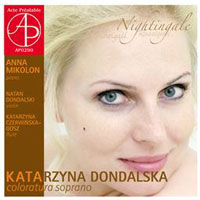
MusicWeb: Nightingale
A few years ago I reviewed a disc with former Cardiff Singer of the World finalist Katarzyna Dondalska and, in the main, very positively (see review). There she sang songs by three Polish composers. On the present disc she throws her net a bit wider and catches no fewer than sixteen composers of many nationalities. This disc is more of a playground for coloratura fireworks but that doesn’t exclude musical values of a higher dignity than sheer technical brilliance.
Ms Dondalska is in good voice, she is technically accomplished, her intonation is pinpoint also in the uppermost register and her trill is impressive. On the debit side we can enter a certain hardness of tone in the book-keeping and occasionally a mite too much vibrato. Overall, though, this is very musical singing with a good sense of musical phrase and nuance. Alyabyev’s Solovey is a legendary showpiece for operatic nightingales (‘solovey’ means literally ‘nightingale’) and Ms Dondalska’s stratospheric flights are fascinating. Alyabyev (also transliterated as Alabiev or Alabieff) is regarded as the father of Russian art song and this one was written in prison in 1825, where he was detained for alleged murder. The song became known to wide audiences when Pauline Viardot inserted it in Rosina’s singing lesson in Il barbiere di Siviglia, a tradition that was continued by both Adelina Patti and Marcella Sembrich.
Nightingales are in plentiful supply on this disc. Rimsky-Korsakov’s beautiful song also deals with this modest little creature, as does Delibes’ long and elaborate song with obbligato flute, expertly played by Katarzyna Czerwinska-Gosz. Delibes had a soft spot for high coloraturas, just think of The Bell Song from Lakmé and also the delectable Les filles de Cadix. Dondalska also shows in this wide-ranging song that she isn’t bad in the contralto range either. The song in this arrangement by Ary van Leeuwen is dedicated to Lily Pons, ‘the admirable singer’.
The following two songs by Polish composers are settings of the same poem by Adam Mickiewicz, and through my knowledge of Polish I guess that the nightingale is the central character here too. ‘Słowik’ is ‘nightingale’ according to Google. Niewiadomski’s setting is very beautiful with no exhibition, and Zelenski’s version has quite an elaborate piano accompaniment.
With Dell’Acqua’s Villanelle we change birds for a moment; here it’s a swallow the poet sees flying by. With lovely violin playing and nuanced singing this beautiful song is a gem. It is also one of the great showpieces for coloratura display.
Natan Dondalski’s violin is present also in Schumann’s idyllic Sommerruh. We glimpse a nightingale here too, but it isn’t in virtuoso mood. It sings with subdued warmth and beautiful legato, aided by a likewise warmly singing violin. Rarely heard but truly beautiful.
Thomas Haynes Bayly is probably better known as a poet and dramatist, and many of his poems were successfully set to music by Bishop. Bayly also set of his own poems to music and this simple little melody, adorned with some virtuoso embellishments, is quite sweet. Here the fluttering wings belong to a butterfly. I’m afraid I am at loss to identify what flying creature is depicted in Rozycki’s lovely song, one of my favourites with its impressionist accompaniment. The little blue bird in Jacques-Dalcroze’s song is also beautiful.
Saint-Saëns returns to the nightingale theme in his two songs. The first of them requires strong singing and the piano part was clearly created for a brilliant pianist. The second of them, a vocalise from the drama Parysatis by Jane Dieulafoy is a sheer showpiece - something to admire for the sake of the singer’s technique and range.
For me Dominick Argento is synonymous with the 1988 opera The Aspern Papers, written for Elisabeth Söderström and Frederica von Stade. Von Stade didn’t sing in it when it was mounted in Stockholm a couple of years later but Söderström did. The whole opera was a strong experience which I had to see twice. Spring is a charming part of Six Elizabethan Songs where several bird sounds are heard but only the cuckoo is identified. An ornithologist would probably recognise the others.
Alban Berg’s Sieben frühe Lieder have more or less become standard fare of late and Die Nachtigall is no more difficult to come to grips with than Richard Strauss or Hugo Wolf. This is high romantic music. Far more advanced harmonically is Szymanowski and Słowik is deeply fascinating. I have never associated Hans Pfitzner with light-hearted spring mood, but here he lets his hair down. The ‘fink’ (finch) of the title is actually accompanied by a nightingale.
Franz Grothe, who is allotted no fewer than four songs, was one of the most popular light music composers in Germany. He also produced music for a large number of films, including the 1941 Die schwedische Nachtigall, about the soprano Jenny Lind. The title role was played by Ilse Werner but the songs were dubbed by the great Erna Berger. Die Nachtigall with flute obbligato has a noble central melody. In general style his music is steeped in German operetta style, easy on the ear and not without charm. In the last two of them we again hear the excellent Natan Dondalski’s violin. Die Lerche und der Geiger (tr 20) is also film music but though the German Wikipedia list an enormous number of film scores from his pen, this one is missing.
By the side of some inevitable showpieces for coloratura display we get many charming and entertaining songs that are well worth any listener’s attention. They are performed stylishly and with affection.
Göran Forsling
Opera Nederland (10/2013)
Nieuwe CD
Het Poolse coloratuurwonder Katarzyna Dondalska zong al een aantal keren in Nederland en is dit seizoen te horen als de Koningin van de Nacht bij de Deutsche Opera am Rhein in Düsseldorf. Haar derde solo-CD ‘The Nightingale’ is nu uitgekomen. Hierop zingt zij werken van 16 componisten, die gaan over nachtegalen, vinken, vlinders en ander gevogelte geassocieerd met coloratuursopraan. De stem van Katarzyna Dondalska is - anders dan van andere coloratuursopranen - afgedekt in het middenregister en breed in het kopregister. Zij schakelt eenvoudig naar haar borstregister en heeft een schijnbaar makkelijke toegang tot een uitgebreid flageoletregister. Dit flageoletregister reikt bij haar tot boven de C4 (1760 Hz) - door wetenschappers ook wel C7 genoemd - een noot ook hoorbaar op opnamen van Erna Sack (“In deinen Augen liegt all mein Glück” van Kaufmann) en Mado Robin (repetitieopname op het label Marianne Melodie 031193). Op de nieuwe CD van Katarzyna Dondalska staan bekende en vooral ook minder bekende werken. Hoogtepunten zijn de liederen “Słowiczu mój” van Żeleński en “Rajski ptak” van Różycki, daar waar zij het geluid goed bij zich houdt en de stem niet groter wil maken dan hij is. Haar sopraan komt ook goed tot haar recht in de vier liederen van Franz Grothe, waaronder het “Lied der Nachtigall” uit de Nazi-film ‘Die Schwedische Nachtigall’ uit 1941. Hier wordt zij begeleid op dwarsfluit door Katarzyna Czerwińska-Gosz. Violist Natan Dondalski is op vier liederen te horen, waaronder twee liederen van Grothe. In “Die Lerche und der Geiger” zijn er fraaie flageoletten van violist én sopraan tegelijk. Pianiste Anna Mikolon begeleidt bescheiden. Het CD-boekje bevat een introductie van de sopraan, biografieën en de volledige teksten van de werken. Het boekje vermeldt voor het lied “Seit vielen tausend Jahren gibt es Lieder” abusievelijk niet de titel van het lied zelf, maar de titel van de film waaruit het lied komt, namelijk ‘Die Melodie des Lebens’ uit 1964. (Acte Préalable AP0290) *****
Maestro (15.9.2013)
Słowik – nowy album Katarzyny Dondalskiej
Niemal cała dotychczasowa kariera Katarzyny Dondalskiej, laureatki wielu międzynarodowych konkursów wokalnych, jest związana ze scenami niemieckimi. Najpierw uczyła się w rodzinnym Olsztynie, później przez rok była studentką PWSM w Gdańsku, w klasie Haliny Mickiewiczówny, następnie kontynuowała studia w Hochschule für Musik w Würzburgu. Zaliczyła też kursy mistrzowskie u Sylwii Geszty. Na scenie debiutowała w 1995 roku partią Królowej Nocy w Operze w Detmold. W latach 1998-2000 była solistką Opery w Heidelbergu.  Potem podziwiano jej koloraturowy sopran o krystalicznie czystym brzmieniu prowadzony z wirtuozowską techniką w Alte Oper we Frankfurcie nad Menem, Staatstheater w Mainz, Karlsruhe i Darmstad oraz w Natzionaletheater w Mannheim. Do tego należy dodać: Augsburg, Heidelberg, Düsseldorf i Monachium. Największe uznanie przyniosły jej koloraturowe bohaterki oper Mozarta: Królowa Nocy, Blonda i Konstancja oraz Zerbinetta w Ariadnie na Naxos R. Straussa. W 2004 roku Opera w Houston była miejscem jej amerykańskiego debiutu. Z kolei w argentyńskim Teatro Colon zadebiutowała partią Konstancji w Uprowadzeniu z Seraju Mozarta.
Będąc rozpoznawalną w świecie śpiewaczką w Polsce pozostaje artystką niemal zupełnie nieznaną. Pierwszy raz pojawiła się na scenie Opery na Zamku w Szczecinie w sierpniu 2008 roku podczas głośnego koncertu „Królowe Nocy”. Świadkiem tego występu była Zdzisława Donat, jedna z najlepszych na świecie wykonawczyń partii Królowej Nocy i innych koloraturowych ról, która zachwycała się wówczas nie tylko jej pięknym krystalicznie brzmiącym sopranem, ale również swobodą osiągania tych najwyższych dźwięków i czystością intonacji. Po raz pierwszy – dodaje Pani Donat – usłyszałam śpiewaczkę, która spontanicznie improwizuje kadencje. Drugi raz pojawiła się Pani Dondalska na polskiej scenie również w Szczecinie, gdzie na zaproszenie dyrektora Kunca zaśpiewała partię Ewy w Hrabinie Moniuszki w 2010 roku. Trzeci występ jest związany z Operą Narodową w Warszawie, na scenie której zaśpiewała rolę tytułowego Słowika w operze Strawińskiego. „Katarzyna Dondalska, wyjątkowej klasy sopranistka koloraturowa młodej generacji, wykonawczyni partii Słowika, urzeka swym głosem, jego rozpiętością i lekkością.” – napisała Anna Czajkowska. Mimo odniesionego sukcesu i kilku propozycji kolejnych ról nagle kontakt z tym teatrem zerwał się. – Niestety - wyjaśnia - kontakt się nagle urwał i umowy które miały dojść w ciągu miesiąca już nie doszły.
Krajowe perypetie jakoś zupełnie nie przełożyły się na rozwój kariery tej artystki tyle tylko, że nie na naszych scenach, a szkoda!. Jej najświeższym wydarzeniem jest płyta The Nightingale zawierająca wybranych przez śpiewaczkę dwadzieścia utworów napisanych na sopran koloraturowy, są wśród nich „ptasie” pieśni Szymanowskiego, Grothe, Schumanna, Żeleńskiego, Niewiadomskiego, Rimskiego-Korsakowa, Delibesa, Berga i Saint-Saënsa. Ich wspólnym mianownikiem jest koloratura, będąca tutaj środkiem artystycznego wyrazu. To ona nadaje charakter całej płycie. Przyznać należy, że Dondalska posługuje się nią z niebywałym mistrzostwem. Wszelkie ozdobniki wyśpiewuje z lekkością, wielką precyzją i wdziękiem oraz swobodą podporządkowując ją w znacznej mierze dramaturgii prezentowanego utworu. Choć chwilami nie ustrzegła się koloratury dla samej koloratury. Warto jeszcze podkreślić, że potrafi nadać głosowi miękkie ciepłe brzmienie, a prowadzona naturalnie, bez dociskania wysokich, dźwięków fraza układa się swobodnie i miękko. Miłośnicy koloraturowego śpiewu powinni ten album mieć w swojej kolekcji.
Adam Czopek
Uckermark Kurier (25. 3. 2013)
Klangsuche nach dem Frühling – Peter Buske
… Damit der alte Winter in seiner Schwäche sich noch rascher zurückziehen möge, vertrauen die „Preußen“ zusätzlich auf die Wirkung der koloraturensicheren Kehle von Katarzyna Dondalska. Bereits bei ihrem Auftrittscouplet „Ach, wir armen Primadonnen“ aus Millöckers „Der arme Jonathan“ schleudert sie gläserne Spitzentöne in den Saal, holt aus Tiefenbereichen manche Beilage fürs Verruchte. Mit gestochener Verzierungsakrobatik begeistert sie beim „Frühlingsstimmenwalzer“ von Johann Strauß, wo sie mit stimmlicher Leichtigkeitder besungenen Lerche im Himmelsblau Konkurrenz macht. Doch sie kann auch, „Draußen in Sievering“, weit schwingenden Melodiebögen das erforderliche schmachtende Sentiment verleihen. Oder ganz kokett die fledermausische „Unschuld vom Lande“ spielen. …

Polish Soprano Puts Moscow Metro Sound System in Danger
(22. 1. 2013)
One of the hardest things for an opera reviewer is to do is to describe the lead singer's voice. The reviewer could list off notes or compare the voice to that of a bird.
Polish soprano Katarzyna Dondalska reached a new milestone that reviewers can use to quantify her singing capacity. Her voice reaches high enough to damage the loudspeakers in Moscow's metro.
Dondalska will be in Moscow on Jan. 25 to perform with the Morphing Vienna Chamber Orchestra at the Viennesse Strauss Gala 2013.
The concerts' organizers wanted to submit ads to play while people are riding the metro's escalators, but some of the notes turned out to be too high and potentially damaging to the audio systems. In the end, the organizers had to choose another sound clip for the ad.
The Vienna-based chamber orchestra is returning to the city for the second time with a number of classical compositions from the repertoires of renowned world composers, including Johann Strauss and Wolfgang Mozart.
Along with Dondalska, the concert will feature violinist Denise Nittel, conductor Georg Mark and a special guest performance by composer and performer Krzesimir Debski from Poland.
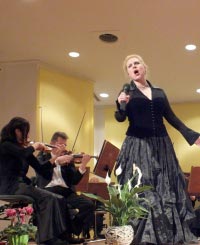 Foto: Lydia Reimann
Foto: Lydia Reimann
Nordkurier (17. 10. 2012)
Mit Musik von Franz Grothe wurde am Freitag die Unterhaltungsreihe der Uckermärkischen Kulturagentur eröffnet. Traditionell finden die Konzerte der Reihe im Kultur- und Plenarsaal Prenzlau statt, der beim Eröffnungskonzert bestens gefüllt war. Frank Zacher dirigierte das Preußische Kammerorchester. Als Solistin brillierte Katarzyna Dondalska, Ausnahme-Koloratursopranistin aus Polen. Zum 30.Todestag von Franz Grothe erklangen Werke wie „Die Melodie des Lebens“, „Das Wirtshaus im Spessart“ und „Sing mit mir“.
Schwäbische Zeitung (31.12.2012)
Philharmonie schenkt Zuhörern schönen Abend
Silvestergala im Stadtforum - faszinierende Sopranistin Katarzyna Dondalska
… Mit einer großen, durchtragenden Stimme zog die Sopranistin Katarzyna Dondalska die Zuhörer in ihren Bann und unterstützte dies durch eine betörende Mimik und Gestik, etwa beim „Una voce poco fa“ aus dem „Barbier“ oder wenig später das „O luce di quest anima“. Mitreißend waren immer wieder ihre großen Koloraturen. Betörend und leidenschaftlich erklang der „Kusswalzer“ (Il Bacio) von Luigi Arditi. … Im Lied der Adele „Spiel’ ich die unschuld vom Lande“ gab sich Katarzyna Dondalska mal spitzbübisch, mal leidenschaftlich … Und beim „Frühlingsstimmenwalzer“ faszinierte Dondalska ein weiteres mal durch wunderschöne Koloraturen, die sie mit großer Leichtigkeit sang. …
 Silvana Bazzoni-Bartoli mit Katarzyna Dondalska
Silvana Bazzoni-Bartoli mit Katarzyna Dondalska
DrehPunktKultur(11. 7. 2012)
Silvana Bazzoni-Bartoli, mit Katarzyna Dondalska
... Im Abschlusskonzert ... brillierten die bravouröse polnische Koloratursopranistin Katarzyna Dondalska, die bis in die viergestrichene Oktave zu turnen und ebenso mit feinster Pianissimo-Kultur aufzuwarten verstand ...
Main Post (3. 7. 2012 )
Kissinger Sommer
... Allen voran brillierte hier die in punkto Höhe und Geläufigkeit sagenhafte Koloratur-Sopranistin Katarzyna Dondalska, die mit der berühmten Rossini-Arie „Una voce poco fa“ begeisterte. Dass sie auch in höchster Höhe im feinsten Pianissimo jeden Ton zu gestalten versteht, bewies die Polin mit „Il bel sogno di Doretta“ von Puccini. ..
National Theater Warschau (Mai/Juni 2012)
"Słowik" w Operze Narodowej - pisze Anna Czajkowska 2012
... A jednocześnie jest to spotkanie z przepięknym śpiewem - Katarzyna Dondalska, wyjątkowej klasy sopranistka koloraturowa młodej generacji, wykonawczyni partii Słowika, urzeka swym głosem, jego rozpiętością i lekkością...
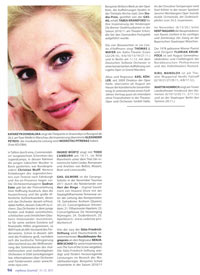
Orpheus Oper International Magazin (11. 12. 2011)
Berlin Classic open air Orff "Carmina Burana"
... die Solistin Katarzyna Dondalska mit himmelhoch strebendem, wundervoll timbriertem, technisch brillant eingesetztem Sopran ...
Wiesbadener Kurier (13.09.2011)
Wenn italienische Opernmusik angesagt ist, erwarten die Zuhörer Stimmen, die das glutvolle und leidenschaftliche Melos dieser Musik überzeugend präsentieren können, wobei man immer wieder feststellt, dass die Fähigkeit zur Produktion hoher und lange gehaltener Töne im Mittelpunkt des Interesses zu stehen scheint. Mit dieser Fähigkeit konnte vor allem Sopranistin Katarzyna Dondalska brillieren, die dem Fachbereich der lyrischen Koloratursängerin zuzuordnen ist, mit zusätzlichen Fiorituren in teils Schwindel erregender Höhe und biegsam geführter Stimme Anlass zu wahren Ovationen gab, ein Musterbeispiel stimmlicher Akrobatik, sehr schön und mit kapriziöser Eleganz gesungen vor allem die Arie der Rosina aus Gioacchino Rossinis „Barbier von Sevilla“...
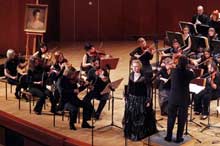 Koncert Katarzyny Dondalskiej
Koncert Katarzyny Dondalskiej
(fot. Stanisław Bednarz)
Sztuka koloratury
Sala koncertowa gdańskiej Akademii Muzycznej wypełniła się do ostatniego miejsca. Trzeba było dostawiać krzesła, a i tak wiele osób gromadziło się w przejściu – by choć na stojąco wysłuchać koncertu Katarzyny Dondalskiej, której towarzyszyła Akademicka Orkiestra Kameralna pod dyrekcją Przemysława Stanisławskiego, którą przygotował dr Andrzej Kacprzak. Dondalska zaczęła od arii Rozyny z I aktu Cyrulika Sewilskiego Gioacchino Rossiniego. I już w tym pierwszym utworze zachwyciła publiczność pięknym, bogatym i doskonałym technicznie głosem. Myślę, że tytuł koncertu Stratosferyczne przestrzenie głosu koloraturowego najlepiej opisuje jej możliwości wokalne. Po kończącej koncert arii Lindy z opery Linda di Chamounix Gaetano Donizettiego urzeczona publiczność nie chciała wypuścić sopranistki ze sceny. Owacje zdawały się nie mieć końca. Na wyraźne życzenie publiczności artystka bisowała dwukrotnie.
Badisches Tagblatt (30.06.2009)
... Die polnische Sängerin Katarzyna Dondalska lieh ihre wunderbare Stimme den Gestalten einer "Lucia di Lammermoor"...
...Es war eine Paraderolle der Callas, aber auch der Dondalska, die eine geschmeidige, gut geführte Sopranstimme besitzt, die mit berührender Intensität tief ins Herz dringt...
Polska Głos Wielkopolski (20.2.2009)
Filharmonia Poznanska
Ale objawieniem wieczoru okazała się młoda wokalistka rodem z Bydgoszczy, Katarzyna Dondalska. Edukowana w Olsztynie i Wurzburgu (Niemcy), jest dość rzadkim przykładem koegzystencji skrzypaczki i wokalistki w jednej duszy artystycznej. Być może to właśnie, przy oczywistym darze natury i tytanicznej pracy, pozwala urodziwej śpiewaczce poruszać się z taką wirtuozerią w regionach kojarzonych z legendarna Królowa Nocy z "Czarodziejskiego fletu" wielkiego Mozarta i jej niebo-tycznymi wprost koloraturami. Kompozycje Masse i Benedicta, odpowiednio aranżowane, pozwoliły Dondalskiej poszaleć w reje-strach dawno lub może nawet nigdy nie słyszanych w tej szacownej sali koncertowej. Bo i trzykrotne "as" i "a" pięknie postawione w kulminacji gąszczu karkołomnych biegników i wokalnych ozdobników, i zadziwiająca lekkość, sprawność i precyzja intonacyjna po prostu zaparły dech w piersiach.
Mainpost (10. 8. 2008)
Eine starke Leistung boten die Sopranistin Katarzyna Dondalska sowie die Schlagzeuger Martin Amthor und Stefan Johannes Walter mit ihrem neuen Programm, das sie einen Tag nach der Premiere im Staatsbad Brückenau im Saalbau Luisengarten in Würzburg präsentierten. ...
Das Spiel der BKO-Mitglieder war nuancenreich und spannend wie die Stimme von Katarzyna Dondalska. Die mit Walter verheiratete Polin begeisterte durch galante Virtuosität und enorme Höhe – bei der Uraufführung der von ihrem Mann komponierten Percussive Serenade meisterte sie ein dreigestrichenes f. ...
Gazeta Wyborcza (3. 8. 2008)
Jednak prawdziwa władczynia stratosfery okazała sie tym razem Katarzyna Dondalska, wyjatkowej klasy sopranistka koloraturowa. Tak odwaznie w swoim wystepie atakowała dzwieki, niezaleznie od wysokosci i dynamiki osiagajac ekstremalnie wysokie nuty, ze wzbudzała najwyzsze zachwyty publicznosci. Kariere robi na Zachodzie, a jej wystep w Szczecinie był rzadka okazja do posłuchania jej w Polsce.
Kölnische Rundschau (17. Juni 2008)
Eine Operetten-Diva wie aus dem Lehrbuch ist Katarzyna Dondalska, die als "Unschuld vom Lande" brillierte.
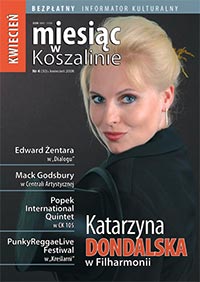
La Nuova, (3. 6. 2008)
... e poi la Nannetta die Katarzyna Dondalska, dal timbro fervido e di convincente caratterizzazione.
Dziennik Miasto (7. 4. 2008)
... Artystka ... dysponuje pieknym, wyrownanym we wszystkich rejestrech sopranem o olbrzymiej, unikalnej skali: do trzykreslnego "b", co sie jeszcze w historii wokalistyki nie zdarzylo. Najwazniejsze jednak, ze, przy tych fenomenalnych warunkach, spiewa z niezwykla kultura, muzykalnoscia - i nienaganna dykcja ... Kazdy z utworow byl interpretacyjnym klejnocikiem blyszczacym temperamentem, wokalna brawura i uroda cieplego sopranu solistki.
L'Unione Sarda (14. 10. 2007)
... Katarzyna Dondalska, la servetta Blonde, che non le è da meno definendo il suo personaggio con modi effervescenti e vocalità brillante. ...
Opernwelt (06/2007)
... hervorragend die Nachtigall Katarzyna Dondalskas ...
Opera Now (05/2007)
The voices of other contemporary composers, especially Strauss (Zerbinetta) and Wagner (Meistersinger) can be clearly detected - this is Braunfels' first period - and there are passages of great beauty, especially at the beginning of the second act in the scene between Hoffegut and the Nachtigall, sung with incredible virtuosity and lightness by Katarzyna Dondalska.
Il Martino (30. 4. 2007)
... con ovazioni speciali per Katarzyna Dondalska (Usignolo), soprano acuto in vena di finezze vocali deliziose, ...
La Sicilia (29. 4. 2007)
... Katarzyna Dondalska un Usignolo dal virtuosismo vertiginoso ...
La Nuova (29. 4. 2007)
... a cui segue l'introduttiva aria di Katarzyna Dondalska (l'Usignolo), soprano di notevole agilità vocale, che deve inerpicarsi nel registro piú acuto per trillare, gorgheggiare, cinguettare, cimentandosi in una serie die onomatopee, che pure il coro ...
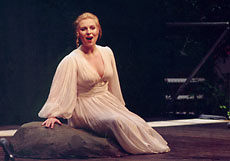
Die Welt (15.02.2006)
Mit einem schlanken, bewegenden Oratorien-Sopran formte die Polin Katarzyna Dondalska die Titelheldin. Zerrissenheit und namenlose Zartheit prägten ihre Arie "Trostlos schluchzet Philomele", in der Dondalska beispielsweise mit einem unerwarteten Atmer vor dem letzten Satzteil ihre innere Bewegung artikulierte.
Hamburger Abendblatt (15.02.2006)
Katarzyna Dondalska war mit ihrem glockenhellen Sopran eine wunderbare Zaide.
General-Anzeiger, Bonn (27.02.2006)
... Ein Genuss. Das war auch die immer wieder verblüffende Stimme von Katarzyna Dondalska, die nicht nur mit unglaublichen Höhenflügen, sondern auch mit einer stupenden Stimmtechnik und einem variantenreichen Timbre zu beeindrucken wusste. Ob nun im ernsten Fach mit der Arie "Una voce poco fa" aus Gioacchino Rossinis "Barbier von Sevilla" oder dem mit operettenhafter Leichtigkeit gesungenen und auch schauspielerisch gekonnt inszenierten "Schwips-Lied" von Johann Strauß, Dondalska traf stets den richtigen Ton.
Reutlinger Nachrichten (29.10.2005)
..., gelang der jungen Koloratursopranistin Katarzyna Dondalska eine bezwingend individuelle und sängerisch glänzende Interpretation der Kreuder-Melodien. Nicht nur stimmlich, auch in Ausdruck und Darstellung stand sie souverän darüber.
Es war spürbar: In der höchsten Höhen fühlt sie sich wohl, die Ironie der Texte macht ihr Spaß und reizt zum Ausdruck – von "Romantisch sein ist schön!" bis "Alles Lüge!" – , ...
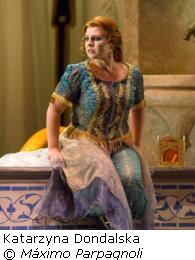 Frankfurter Allgemeine Zeitung
Frankfurter Allgemeine Zeitung
... interpretó con juvenil encanto el vals „Frühlingsstimmen“ pero fue sobre todo premiada con gran júbilo por su grandiosa coloratura en el „Schattenwalzer“. Con su perfecta técnica vocal superó sin esfuerzo todas las dificultades. El aplauso más entrañable lo consiguió por tonos agudos, cantados sin impureza alguna con una excelente ligereza y una seguridad sin igual.
BBC online news
La soprano de coloratura polaca Katarzyna Dondalska, una delicia para los admiradores de los canarios, puede cantar cómodamente una octava más alto de lo que la música requiere. Pero para ser músico la voz que desafíe las leyes de la gravedad debe ser moderada y después de una sensacionalmente embellecida ‚Una voce poco fa‘ del Barbero de Sevilla de Rossini, su necesidad de demostrar sus posibilidades la llevó a un mejor y mayor efecto musical en el aria de Zerbinetta de Ariadne de Strauss. No pude evitar pensar en el hecho de que escuchar a la Reina de la Noche en un teatro es normalmente un momento de estrés - llegará o no llegará la cantante a las notas altas?- Pero en esta ocasión tales notas demostraron ser significativamente más bajas que Ias que puede alcanzar su rango de voz. Estoy seguro de que la carrera de Katarzyna en papeles de coloratura seguirá floreciendo.
Opera
Su voz es … precisa y de rango amplio: emitió una nota tan aguda en su cadenza que podría resultar peligroso para un caballero de avanzada edad el escucharla…(¿era un „la“? Por lo menos un „sol“).
Houston Press
… el premio de canto fue para la soprano polaca Katarzyna Dondalska en su debut en la HGO con el papel de la Reina de la Noche. Consiguió superar con aplomo los obstáculos en la coloratura del primer acto…

Houston Chronicle
… la soprano polaca Katarzyna Dondalska fue brillante y todo un espectáculo…
Berliner Morgenpost
... y cuando cantó Katarzyna Dondalska..., casi detuvo la respiración del público. Su casi increíble canto, lleno de ornamentaciones, finalizó con un „la“ sobreagudo. Ya antes de esta actuación la polaca era conocida como especialista en cantar lo «incantable»…
Berliner Morgenpost
Como estrella de la noche brilló la polaca Katarzyna Dondalska. Con una virtuosidad impecable se enfrentó a una pieza como el „Frühlingsstimmenwalzer“. Como Adele de El Murciélago y con Schwipslied demostró además su talento como comediante.
The Dallas Morning News
Katarzyna Dondalska puede cantar las notas estratosféricas de la Reina de la Noche y moverse por la coloratura de esta pieza con escaso esfuerzo.
Die Rheinpfalz
...los tonos extremadamente agudos : perfectos y espectaculares
Dortmunder Rundschau
...Coloratura en estado puro... con brillo plateado condujo la soprano su voz a vertiginosos tonos agudos…
Rhein-Neckar Zeitung
Katarzyna Dondalska ofreció una Reina de la Noche con una presencia vocal increíble: la temida aria de la venganza, en la que escénicamente se movió como una sonámubla Lady Macbeth, raramente se ha escuchado con tal incondicionalidad e implacabilidad – una escena sumamente efectiva. Fenomenal el trabajo de la joven cantante.

Rhein-Neckar Zeitung
...provocó un huracán de aplausos con el bonito timbre de su tesitura media y con sus estupendos agudos…
Mannheimer Morgen
...su bonita voz escaló en las variaciones a alturas extremas, en las que su canto no perdió lo más mínimo de su brillo plateado.
Mannheimer Morgen
...y Katarzyna Dondalska fue, con una técnica firme, una graciosa y entrañable Konstanze.
Ruhr Nachrichten
...la joven soprano no es sólo un milagro de la coloratura: posee también una voz cristalina y ligera como una pluma, agudos brillantes y un encanto increíble…
Rheinpfalz Ludwigshafen
... la soprano polaca Katarzyna Dondalska cosechó un gran aplauso tras la cavatina de Rosina del Barbero de Sevilla de Rossini. Fenomenal la precisión con la que resolvió las cabriolas y virtuosas coloraturas pero también llevó a la comparación con el volumen, color y dramaturgia de alguna competidora italiana, cuya interpretación de esta aria siempre suena en la cabeza...
Kölner Stadtanzeiger
...coronó las variaciones de Víctor Massé con un „la“ agudo… ¡una sensación!
Mainpost Würzburg
La mayor parte del mérito fue de la soprano Katarzyna Dondalska, clara, controlada, flexible y cautivadora. Se movió sin dificultad en todas las tesituras, a menudo conmovedora, con encanto melodioso y un piano incandescende en su Puccini para terminar con una interpretación del aria de Violetta „E strano“ de Verdi con dramatismo no fingido y gran sentimiento, que derritió incluso los corazones más gélidos. Chapeau! Altamente profesional esta dama!
Mainpost Würzburg
... que incuso sedujo a espectadores que prefieren otro tipo de música. Ya que la soprano polaca Katarzyna Dondalska, que -entre otras- estudió en la escuela de música de Würzburg, fue una soprano con gran presencia. Su rango de voz abarca desde la coloratura clásica hasta el Jazz, pudiendo llegar a los tonos más agudos y con un alto volumen también a tonos bajos y oscuros. En su voz conviven la inocencia y la elegancia, lo que hace que pueda sonar suave, descarada, frívola o erótica según sea necesario.

Badische Neueste Nachrichten
... Katarzyna Dondalska desprendió un brillo único de una soprano con el aria de la Reina de la Noche de la popular Flauta Mágica con una seguridad probabelmente sin igual en la coloratura, incluso en los tonos agudos.
Neues Volksblatt Linz
Katarzyna Dondalska dominó la difícil coloratura de la Reina de forma impecable.
The Stage
… interpretación excelente también de Katarzyna Dondalska como una encantadora Zerbinetta…
The Western Mail
…Zerbinetta es interpretada por la soprano polaca Katarzyna Dondalska. El papel tiene algunas de las arias más centellenates y exigentes de Strauss con las que deleitar al público y ella desde luego lo hace…
Belfast Telegraph
Hay algunas piezas excepionales – El aria de Zerbinetta (Katarzyna Dondalska la interpretó de forma excelente).
Evening Standard Oxford
La Zerbinetta de Katarzyna Dondalska, la estrella del grupo de cómicos, resultó coqueta y demostró virtuosidad en su famosa aria, que va más allá de la estratosfera vocal.
Bristol Evening Post
Katarzyna Dondalska y sus pierrots representaron una escena de gran hilaridad. Durante esta secuencia Katarzyna hizo una elegante demostración del arte de la coloratura combinado con una interpretación sexy y cómica.
Daily Echo Bournemouth
… la burbujeante coloratura de la Zerbinetta de Dondalska ha sido una muestra impresionante de pirotecnia vocal.

 nach oben
nach oben


 In stratosphärischer Höhe
In stratosphärischer Höhe

 Katarzyna Dondalska wraz z Orkiestrą Symfoniczną Filharmonii Kaliskiej pod przewodnictwem Adama Klocka wykonała wspaniałe walce wiedeńskie, angielskie i francuskie. Sala koncertowa wypełniona była po brzegi. Fenomenalna technika, zmysłowy głos i piękny sopran sprawia, że artystka przyciąga tłumy widzów.
Katarzyna Dondalska wraz z Orkiestrą Symfoniczną Filharmonii Kaliskiej pod przewodnictwem Adama Klocka wykonała wspaniałe walce wiedeńskie, angielskie i francuskie. Sala koncertowa wypełniona była po brzegi. Fenomenalna technika, zmysłowy głos i piękny sopran sprawia, że artystka przyciąga tłumy widzów. A couple of years ago I reviewed a disc titled “Nightingale” with Katarzyna Dondalska (
A couple of years ago I reviewed a disc titled “Nightingale” with Katarzyna Dondalska ( This is the fourth disc with Katarzyna Dondalska that has come my way for review, and I know there are more. The previous one, Dream with me,
This is the fourth disc with Katarzyna Dondalska that has come my way for review, and I know there are more. The previous one, Dream with me,  Strauss Symphony of Canada /
Strauss Symphony of Canada /  ... The program was made up entirely of warhorses. An early highlight was the dazzling showpiece Fruhlingsstimmen by Johann Strauss. This aria tests the stratospheric reaches of a coloratura soprano, the final high note is a B flat above high C. Historically, quite a few singers made a specialty of this, including Mado Robin, Erna Sack, and Miliza Korjus. More recent examples include the late Lucia Popp, Natalie Dessay, Diana Damrau, Sumi Jo, and Kathleen Battle. Well, Frau Dondalska could belt it out with the best of them. Also amazing is her violin playing, Gypsy style. Her website mentions she took up the instrument at age 5! She was partnered in duets from Die Fledermaus and Land of Smiles by the Austrian Gurtelschmied. His is a more modest if pleasant musical theatre voice, with a forward/open placement and almost Italianate sound. He sang "Dein ist mein ganzes Herz" very well, although he got tired near the end of the concert ….
... The program was made up entirely of warhorses. An early highlight was the dazzling showpiece Fruhlingsstimmen by Johann Strauss. This aria tests the stratospheric reaches of a coloratura soprano, the final high note is a B flat above high C. Historically, quite a few singers made a specialty of this, including Mado Robin, Erna Sack, and Miliza Korjus. More recent examples include the late Lucia Popp, Natalie Dessay, Diana Damrau, Sumi Jo, and Kathleen Battle. Well, Frau Dondalska could belt it out with the best of them. Also amazing is her violin playing, Gypsy style. Her website mentions she took up the instrument at age 5! She was partnered in duets from Die Fledermaus and Land of Smiles by the Austrian Gurtelschmied. His is a more modest if pleasant musical theatre voice, with a forward/open placement and almost Italianate sound. He sang "Dein ist mein ganzes Herz" very well, although he got tired near the end of the concert ….







 Frankfurter Allgemeine Zeitung
Frankfurter Allgemeine Zeitung
